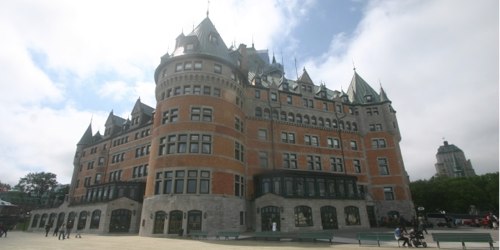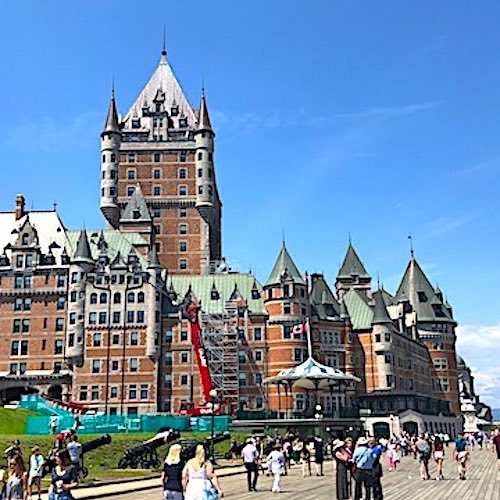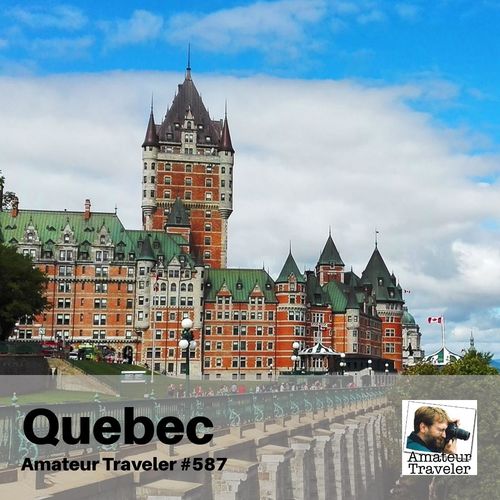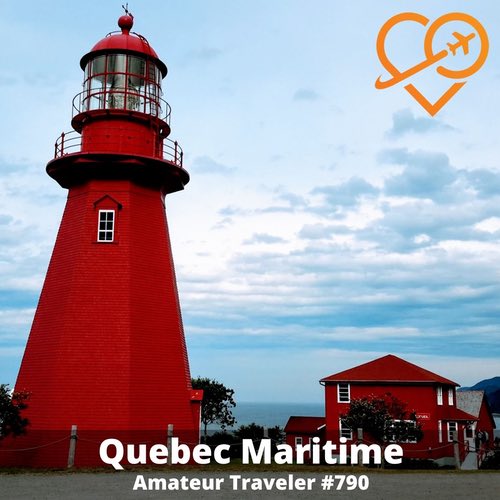Travel to Quebec, Canada – Episode 300
categories: canada travel
The Amateur Traveler talks to Ira Bernstein again, this time about the Canadian Provence of Quebec. Ira suggests seeing both Montreal and Quebec City because of the contrasts in the two major cities in this French-speaking part of Canada.
Ira would personally recommend spending more time in Montreal but would understand those who like Quebec city better. Montreal is an international city with more than just French and English influence, all of which add their influence to a lively restaurant scene. Montreal sits on the Saint Lawrence River and at the base on Mount Royal from which it derives its name.
Quebec City is possibly the most European city in North America and one of the only walled cities. The city is so popular with American’s that we tried to capture it during both the Revolutionary War and the War of 1812. Le Chateau Frontenac dominates the Quebec skyline as it has for more than 100 years.
![]()
right click here to download (mp3)
right click here to download (iTunes version with pictures)
Show Notes
Quebec
Via Rail
Montreal
Montreal Prince-Arthur Street
Old Montreal
Gray Line Montreal Tours
Underground City, Montreal
Olympic Village (Montreal)
The Fashion World of Jean Paul Gaultier
Mount Royal
Quebec City
Battle of the Plains of Abraham
Fairmont Le Château Frontenac
Restaurant Aux Anciens Canadiens
Restaurant Le Continental
Lévis, Quebec
Upper Town (Haute-Ville)
Jean Béliveau
News
German sailor was ‘eaten by cannibals’
Spirit Airlines installs pre-reclined seats
Airline Flushes Away Passenger Comfort
Internet Resources
German sailor was ‘eaten by cannibals’
Spirit Airlines installs pre-reclined seats
Airline Flushes Away Passenger Comfort
Community
vote for the show at PodcastAwards.com
I will be speaking at BlogWorld & New Media Expo in L.A. Nov. 3 – 5
Shannon – “The 3 words question is always the trickiest!”
Steve thinks I need more question variety
Si commented on Travel to European Russia – Episode 299 that he loves Volgograd
- Book Your Accommodation HERE
- Get a Car Rental
- Buy Travel Insurance
- Search for Great Tours HERE
+Chris Christensen | @chris2x | facebook
6 Responses to “Travel to Quebec, Canada – Episode 300”
Leave a Reply
Tags: audio travel podcast, montreal, podcast, quebec, quebec city

 Montreal vs Quebec City: A Traveler’s Tale Of Two Cities
Montreal vs Quebec City: A Traveler’s Tale Of Two Cities Travel to Quebec – Episode 587
Travel to Quebec – Episode 587 Travel to the Quebec Maritime – Episode 790
Travel to the Quebec Maritime – Episode 790 Banff & Calgary, Alberta, Canada – Episode 68
Banff & Calgary, Alberta, Canada – Episode 68

Tim Campbell
Says:October 25th, 2011 at 1:19 pm
Another good podcast Chris, especially since the topic is so close to home for me. I can see the province of Quebec each day as I travel to and from work, on the Ontario side of the Ottawa River. It was a nice followup to two of the cities downstream from Kingston (which you interviewed me for long ago), and equally historic. In fact, Quebec City just celebrated its 400th anniversary in 2008.
Montreal finally paid off the 1976 Olympics debt in late 2006. It was nicknamed the Big Owe and was $1.5 billion.
The Quebec language is French but it is an older version than the language spoken in Paris. The Quebec phraseology is quite old while the Parisians have continued to evolve their language. In fact, the “international” French taught next door in Ontario schools is the Parisian French, which creates a bit of a barrier between Ontario students and their fellow countrymen.
The Fairmont chain of hotels across Canada are the grandest and most historic in the country. Most were formerly owned by the railway companies and built to be destinations to travel to, usually one per city.
What, no mention of the glorious dish called poutine?
Tim
Sarah L
Says:October 26th, 2011 at 7:25 pm
Hi Chris!
Congratulations on another great episode and on 300 total episodes! It’s clear that you put lots of time into researching guests and locations. As a native of New England, I’ve driven up to QC several times. I was a bit bummed that Montmorency falls wasn’t mentioned. It’s a great spot. There are stairs up the side of the waterfall (about 275 feet) which offers a great view. There’s also a suspension bridge over the falls. For those who aren’t able to do that many stairs there’s also a tram that goes up to the same level. On a clear day you can see quite far over the St. Lawrence river and it’s only about 12km from Old Quebec. You might want to bring a raincoat though, if you climb the stairs you’ll get wet!
Another great place is the Basilica Ste. Anne de Beaupre, which is 35km from Old Quebec up the St. Lawrence river. Aside from being a beautiful building there are also magnificent stained glass windows. They say miracles take place there and when you walk in there is a column of crutches that have been left there by people who don’t need them anymore.
One thing to watch out for in the city are the murals. They’ve been done by the city on the sides of buildings and are beautiful and show typical Quebec life.
If you’re there in the early spring (there will still be snow on the ground likely) try and go to a sugar shack. We went and had a traditional Quebecois meal- ham, split pea soup and pancakes with syrup which was followed by singing in French and English. After the singing everyone goes out into the night and enjoys hot maple syrup poured onto snow in troughs, which you roll onto a popsicle stick like a maple lollipop. It’s great fun! The place we went also had sleds and stuff so you could get in touch with your inner child and play in the snow. It’s a great way to spend an evening.
Well, now that I’ve written you a book about Quebec I’ll sign off. Keep up the great work!
–Sarah
Pak Tam
Says:November 3rd, 2011 at 4:38 pm
I just finished listening to your latest episode of Travel to Quebec, & I regretfully have to say I was disappointed. I understand your guest may be an older gentleman whose traveling style is not too active, or knowledge of my adopted hometown not too deep. However I find his trips haven’t shown him 1 10th of how special Quebec is. May I point out the following so he may enjoy the province more next time?
1. To understand Quebec’s soul, it’s a mortal sin to not having mentioned or tried poutine, at least once.
2. To understand Montreal’s soul, it’s a mortal sin to not having mentioned or tried Schwartz smoke meat, at least once.
3. Montreal is a pedestrian’s city with many delightful & safe neighborhoods – one can & should visit the whole core attractions w/o a car. Especially in the summer, main thoroughfares are often closed for street festivals with thousands attending. These party should not be missed – most notable are the Jazz Fest & Francophonies which offer countless free open-air performances in the heart of downtown.
4. Another mega attraction in the summer is the F1 Race, held on a man-made island tract on the St Lawrence River. The annual race & related festivities draw 100 of thousands visitors from near & far.
5. Mont-Royal Park – our Central Park – is a lot more than just a pretty view of the Olympic Stadium. Beside being an urban sanctuary like many other parks, it is also the drum circle (called Tam-Tam), the public beach volleyball parties, the epic battleground for Medieval enthusiasts.
6. The most important neighborhood to visit is of the Plateau. At the foot of Mont-Royal, it had been the welcome committee for different waves of immigrants – the Jews, Portuguese, the Spanish, the Latino etc. As a result, the place is packed with all the ethnic restaurants. One can have tapa for starters, then hop across the street for smoked meat, then finally nata for desert.
7. The terrace culture is not to be missed either. As a matter, that’s the only way some people will have a meal in the summer.
8. Cabane la sucre is the best way to taste maple syrup, or the real quebecois cuisine for that matter.
9. The Carnaval de Quebec is a must if one can manage to visit in the winter. Quebec is 10 times better to me after I went down on the ice slide in front of Chateau Frontenac.
10. Night life, night life, night life!!
I can write more & in further details, but then what else can I talk on your show?
Pak, Montreal
chris2x
Says:November 10th, 2011 at 7:38 am
On Nov 7, 2011, at 3:17 PM, joseph eisinger wrote:
Great programs, just got to the Quebec episode. I found it great but left out some of the lesser known items.
You can stay at the University of Laval during the summer. Dorm rooms have two single beds, there is a direct bus to the Frontenac and is much less expensive (but not as impressive). A bus pass for the day/week can be purchased there also.
You can take the bus to Parc de la chute Montmorency directly outside the dorms at the University. This is a 250 foot waterfall. The bus leaves you at the hotel at the top of the falls. I would suggest taking the path from the hotel over the falls, and then down to the foot of the falls. There is a cable car that will take you back up to the hotel.
Just north of the Parc is the bridge over to the Isle of Orleans, Rent a car and tour the island. There are many cideries that offer tastes of the cider, both natural and iced. This cider is unique to Quebec, and is fantastic. There are many local farms that produce iced cider, where the apples are left on the tree until several days of -20 degree weather then crushed for the juice, and fermented from then. Makes a wonderful desert wine.
Also within 30 miles of Quebec city is St Anne Dupree. This is a catholic pilgrimage site. The large Cathedrals was made in France and shipped over to Quebec and assembled in the early 1900s. Very impressive but I think the lower church is much more beautiful and has a Quebec style. It is all blue and white with large snowflakes on the ceiling. It reminds me of what the winter palace of the snow princess in the C.S. Lewis’ Narnia would look like. There is a free tour every day, in both french and english. Well worth at least half a day.
About 120 miles north east is Tadoussac. A beautiful little town on the river where you can take whale watching boat tours. A very romantic town with lots of bed and breakfasts and the Hotel Tadoussac (if you are on a Frontenac budget). The whales come right up to the town and into the bay. So you can see them without even taking the boat. The drive is fantastic too. Will remind you of the pacific coast highway. The road going between the mountains and the river, curving and following the landscape. You have to take the free ferry over to Tadoussac, but it leaves every 15 minutes.
Would appreciate knowing that you read this, and if you have any questions would be happy to answer them since I understand that you are planning a trip there.
I was in Quebec in August for several weeks. Forgot to mention that if you follow the Saguenay river up from Tadoussac you will find a landscape that is much like the fjords of Norway. I made it all the way past Sept-iles. At this point, the land starts to be artic, the trees get smaller, with bogs and waterfalls coming off the canadian shield into the St. Lawrence River. The locals take this for granted, but I was very impressed.
The description of the boardwalk is accurate. It is a little like Malory Pier in Key West. Different street performers during the day, in both french and english.
The restaurant reviews were great. The maple sugar pie (tart sucre) is delicous and your dentist will like it too (will pay for his boat). I found the local chain St Hubert a good bargain. Good food, reasonable prices, menus in french and english.
Joseph Eisinger
saridon
Says:February 17th, 2013 at 7:04 am
Une consultation dure en moyenne 60 minutes et vous en ressortirez avec un bilan de santé naturopathique qui permettra de mettre en place un plan thérapeutique individualisé visant à désintoxiquer votre corps et nettoyer votre organisme, la plupart du temps grâce à une cure de drainage organique complète, à base de plantes médicinales non-toxiques.
rajtredebi
Says:February 22nd, 2013 at 1:15 pm
Pour retrouver les origines de la phytothérapie, il faut remonter à 24 siècles avant Jésus Christ où les peuples d’Asie et les Égyptiens pratiquaient déjà la médecine par les plantes. Leurs connaissances nous ont été transmises surtout par l’entremise des Arabes et des moines du Moyen-âge qui cultivaient les plantes utilisées pour le traitement des maladies. Au cours des siècles, la délimitation de l’emploi des plantes est devenue de plus en plus éclairée, et, depuis plusieurs décennies la biochimie moderne y a contribué d’une façon significative.